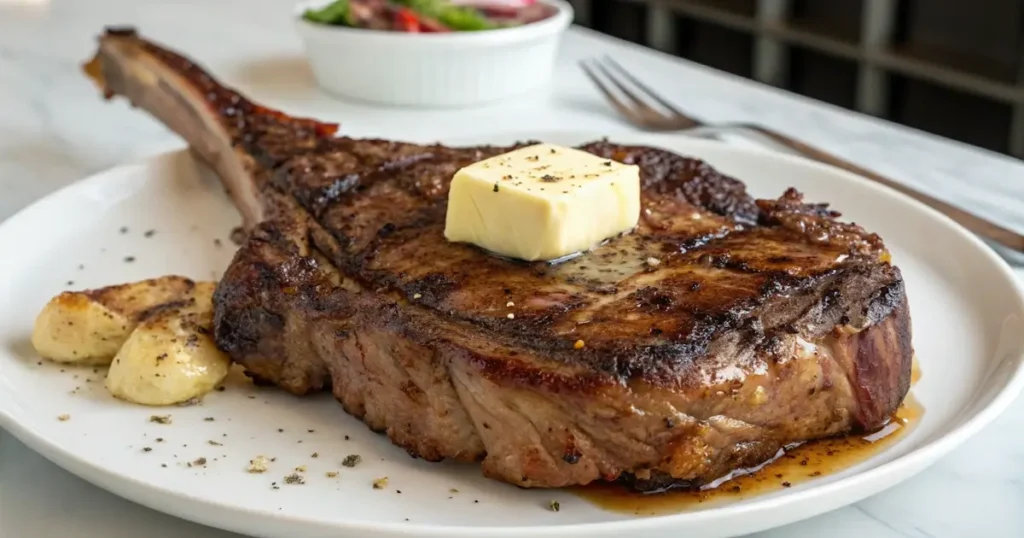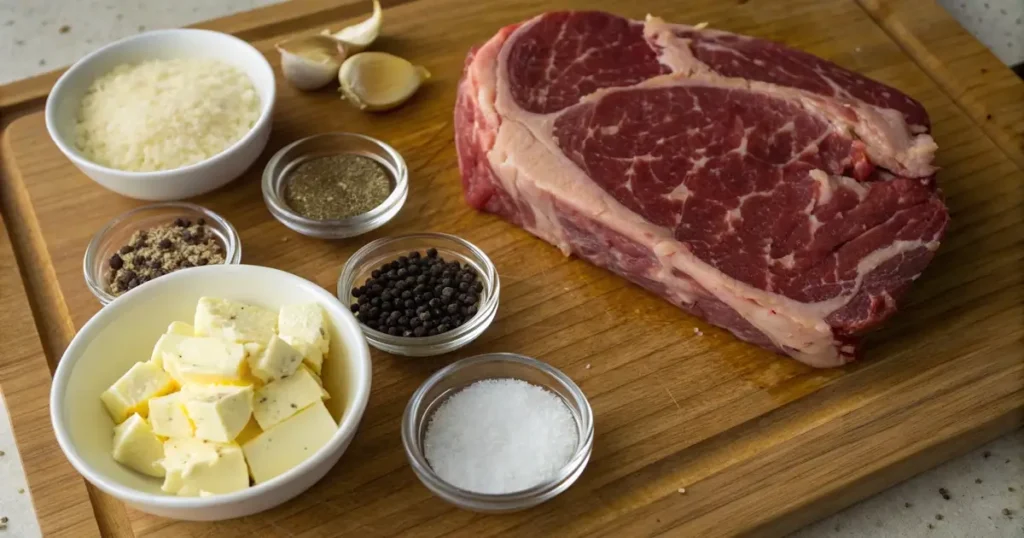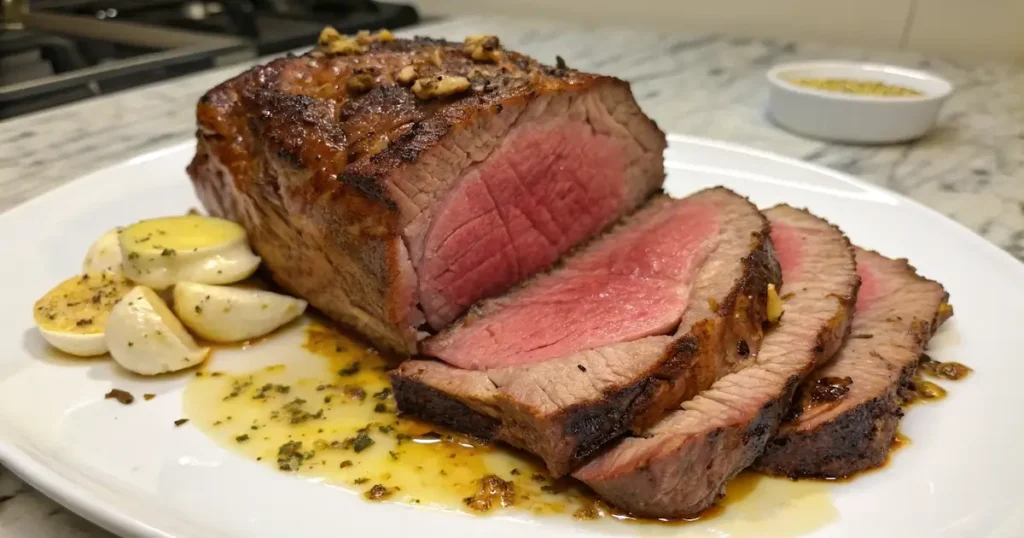When choosing the perfect centerpiece for a special dinner, few dishes rival the bold, savory flavors of a ribeye roast. Whether celebrating a holiday, hosting a family gathering, or just craving a hearty, satisfying meal, a ribeye roast delivers on both taste and elegance. But what makes this cut of meat so special? For starters, its rich marbling ensures each bite is tender, juicy, and full of flavor. The combination of its melt-in-your-mouth texture and robust taste makes it a go-to option for elevating any occasion.
But beyond its incredible flavor, ribeye roast also brings health benefits to the table. Packed with essential nutrients like protein, iron, and vitamins, this roast not only satisfies your taste buds but also supports your overall well-being. Whether you’re a seasoned chef or new to the kitchen, learning how to cook a ribeye roast to perfection is a valuable skill, and this guide will walk you through everything you need to know—from choosing the right ingredients to avoiding common cooking mistakes.
So, if you’re looking for the ultimate dish to impress your guests, or simply want to treat yourself to a luxurious meal, read on to discover why ribeye roast should be your next go-to for special dinners!
Table of Contents
Ribeye Roast and Its Health Benefits
What Makes Ribeye Roast a Great Choice for Special Occasions?
Ribeye roast is the ultimate choice for special occasions, offering a combination of tenderness, flavor, and visual appeal that’s hard to beat. This prime cut of beef, known for its generous marbling, transforms into a juicy, flavorful roast when cooked to perfection. The marbling of fat throughout the meat ensures it stays moist and tender, making every slice melt in your mouth.
Beyond its culinary excellence, the ribeye roast carries a sense of luxury and sophistication, making it an ideal choice for celebrations such as holidays, family gatherings, or milestone events. Its robust flavor profile, which is rich, savory, and slightly smoky, pairs well with a variety of sides and wines, enhancing the overall dining experience.
When preparing a ribeye roast, you’re not just cooking a meal—you’re creating a memorable moment. The aroma that fills the kitchen while it roasts is enough to get anyone excited, and the first cut into the beautifully seared crust reveals the perfectly cooked, tender interior that everyone will enjoy. Whether you’re hosting a holiday dinner or simply want to indulge in a mouthwatering meal, ribeye roast elevates the occasion and provides a memorable dining experience.
Health Benefits of Ribeye Roast: Protein, Iron, and Essential Nutrients
Ribeye roast not only excels in flavor but also packs a punch when it comes to nutrition. This delicious cut of beef is a powerhouse of protein, a nutrient essential for muscle growth, tissue repair, and overall bodily function. A 4-ounce serving of ribeye roast can provide up to 30 grams of protein, making it an excellent option for anyone looking to boost their protein intake.
In addition to being protein-rich, ribeye roast is a great source of iron, a mineral critical for oxygen transport in the blood. Iron helps prevent anemia and supports energy levels, which is especially beneficial if you’re hosting a large dinner or preparing a hearty meal after a long day. The iron found in ribeye roast is heme iron, which is the most bioavailable form, meaning it’s more easily absorbed by the body than non-heme iron found in plant-based foods.
Ribeye roast is also packed with essential vitamins and minerals like zinc, vitamin B12, and selenium. Zinc plays a crucial role in immune function and wound healing, while vitamin B12 is vital for nerve function and red blood cell production. Selenium acts as an antioxidant, protecting cells from damage and promoting overall health.
So, while ribeye roast is undeniably a decadent treat for the taste buds, it also brings valuable nutritional benefits to the table, making it a great choice for those seeking both flavor and nourishment.
Tips for Successfully Making the Ribeye Roast and Mistakes to Avoid
How to Cook a Ribeye Roast to Perfection Every Time

Cooking a ribeye roast to perfection requires some technique, but once you master it, you’ll be able to create a juicy, flavorful roast every time. Follow these steps to ensure that your ribeye roast turns out tender and delicious, with a perfect balance of seared crust and juicy interior.
Bring the Roast to Room Temperature:
Before cooking, allow the ribeye roast to sit at room temperature for about 30–60 minutes. This step ensures the meat cooks evenly. A cold roast straight from the fridge can result in uneven cooking, with the exterior potentially becoming overcooked while the center remains underdone.
Season Generously:
For a flavor-packed roast, season the ribeye with a generous amount of sea salt and cracked black pepper. You can also add garlic, fresh herbs like rosemary or thyme, or a flavorful dry rub to enhance the roast’s taste. Rub the seasoning all over the meat to ensure it’s evenly distributed.
Preheat the Oven:
Preheat your oven to a high temperature of about 450°F (230°C) to get the roast started.The high heat helps to form a nice sear on the outside, locking in the juices. Once the roast is seared, you can lower the temperature to about 350°F (175°C) to allow the roast to cook through to your desired level of doneness.
Use a Meat Thermometer:
The most reliable way to ensure your ribeye roast is cooked perfectly is by using a meat thermometer. Insert the thermometer into the thickest part of the roast, making sure it doesn’t touch the bone. For a medium-rare roast, the internal temperature should be around 130–135°F (54–57°C). For medium, aim for 140–145°F (60–63°C).
Let it Rest:
After removing the ribeye roast from the oven, let it rest for about 15–20 minutes before slicing. Letting the roast rest helps redistribute the juices inside, ensuring it stays moist and tender. Slicing too soon can cause the juices to spill out, leaving the meat dry.
By following these simple steps, you’ll be able to cook a ribeye roast that’s perfectly done every time—crisp on the outside, juicy on the inside, and bursting with flavor.
Common Mistakes When Cooking Ribeye Roast and How to Avoid Them
Even seasoned cooks can make a few mistakes when preparing ribeye roast. To ensure your roast is perfectly cooked every time, here are some common errors to watch out for and tips on how to avoid them.
Not Letting the Roast Come to Room Temperature:
One of the most common mistakes is cooking a ribeye roast straight from the fridge. When meat is too cold, it cooks unevenly, resulting in a roast with a tough exterior and undercooked center. To avoid this, always let your ribeye roast rest at room temperature for 30–60 minutes before cooking. This small step guarantees an even cooking process and ensures the perfect level of tenderness.
Overcooking the Roast:
Ribeye roast is best when cooked to a medium-rare or medium doneness to preserve its tenderness and flavor. Overcooking can lead to dry, tough meat. To prevent this, always use a meat thermometer to monitor the internal temperature. As a general rule, remove the roast from the oven when it’s about 5°F (3°C) below your target temperature and let it rest. The roast will continue to cook slightly during the resting period, increasing its internal temperature by a few degrees.
Not Using Enough Seasoning:
Ribeye roast needs a good amount of seasoning to bring out its natural flavor. Skimping on salt, pepper, and other spices can result in a bland roast. Don’t be afraid to season generously. You can also use fresh herbs, garlic, or a dry rub to enhance the roast’s flavor profile. Remember, the seasoning helps create that delicious crust and enhances the juiciness of the roast.
Slicing the Roast Too Early:
Once the ribeye roast is done, let it rest for 15-20 minutes to allow the juices to settle. Cutting too early will cause the juices to leak out, leaving the roast dry. Always wait before slicing, and you’ll enjoy a more tender and juicy roast.
Forgetting to Preheat the Oven:
Preheating your oven is crucial for achieving that perfect sear on the outside of the ribeye roast. If you place the roast in an oven that hasn’t reached the right temperature, it can cook unevenly, and the outer crust won’t develop as well. Be sure to preheat your oven to 450°F (230°C) before roasting.
By avoiding these common mistakes, you’ll ensure your ribeye roast turns out tender, juicy, and perfectly seasoned every time. A little attention to detail goes a long way in making this dish a standout on any special occasion.
Ingredients and Quantities for the Ribeye Roast and Preparation Steps
Ingredients List: What You’ll Need for the Ribeye Roast Recipe

Creating the perfect ribeye roast requires just a handful of simple ingredients that come together to deliver a rich and flavorful meal. Here’s what you’ll need to prepare this irresistible ribeye roast recipe:
1 Cup Softened Butter
Butter contributes richness and aids in forming a golden, crispy crust on the roast. When combined with garlic, it infuses the meat with incredible flavor, giving every bite a luscious, buttery finish.
6 Cloves Garlic, Minced
Garlic brings a savory depth to the ribeye roast. Minced garlic is blended into the softened butter to coat the meat, adding a fragrant aroma and savory punch to each slice.
1 (4-pound) Bone-In Rib-Eye Roast
The star of the dish! A bone-in ribeye roast is a juicy, tender cut of beef with a robust flavor profile. The bone infuses the roast with extra flavor as it cooks, making this cut ideal for special occasions. The 4-pound size ensures you have enough to feed a crowd.
1 Sea Salt and Cracked Black Pepper, to Taste
Salt and pepper are essential for bringing out the natural flavors of the ribeye roast. The salt helps to draw moisture from the meat, creating a flavorful crust, while cracked black pepper adds a subtle heat and complexity.
These few ingredients work together to create a perfectly roasted ribeye with a golden, crispy exterior and tender, juicy meat inside. Now that you have the ingredient list, it’s time to start preparing your ribeye roast for cooking!
Step-by-Step Cooking Instructions: From Prep to Plating
Now that you have all your ingredients ready, it’s time to cook your ribeye roast to perfection. Follow these simple steps for a flawless, melt-in-your-mouth roast:
Step 1: Prepare the Ribeye Roast
Start by removing the ribeye roast from the refrigerator and letting it come to room temperature for 30–60 minutes. This step guarantees an even cook throughout the roast. Preheat your oven to 450°F (230°C). The high initial heat will help create a crispy, flavorful crust on the roast.
While waiting for the roast to come to room temperature, prepare the garlic butter. In a small bowl, combine the softened butter with the minced garlic, mixing well until it forms a smooth, fragrant paste.
Step 2: Season and Coat the Roast
Season the ribeye roast generously with sea salt and freshly cracked black pepper. Be sure to cover all sides, pressing the seasoning into the meat to create a flavorful crust.
Then, using your hands or a brush, spread the garlic butter evenly across the entire surface of the roast. Make sure to coat every nook and cranny to ensure maximum flavor infusion.
Step 3: Roast the Ribeye
Place the seasoned ribeye roast on a roasting rack in a roasting pan to allow heat to circulate evenly, ensuring thorough cooking.
Roast the ribeye at 450°F (230°C) for 15–20 minutes to sear the exterior, forming a golden-brown crust After 15–20 minutes, reduce the oven temperature to 350°F (175°C) and continue roasting for approximately 1.5 to 2 hours, depending on your preferred level of doneness. Insert a meat thermometer to check the internal temperature. For medium-rare, the target is 130–135°F (54–57°C), and for medium, aim for 140–145°F (60–63°C).
Step 4: Rest and Slice
Once the ribeye roast reaches the desired temperature, take it out of the oven and let it rest for 15–20 minutes before slicing. This resting time allows the juices to redistribute, keeping the roast moist and tender.
Once rested, slice the roast against the grain before serving. Enjoy the perfectly cooked, juicy, and flavorful ribeye roast!
Preserving the Ribeye Roast and Frequently Asked Questions (FAQs)
How to Store Leftover Ribeye Roast

After enjoying your delicious ribeye roast, you may have some leftovers, which can make for fantastic meals the next day. Here’s how to store your ribeye roast to keep it fresh and tasty:
- Let the Roast Cool Down:
Before storing any leftovers, allow the ribeye roast to cool to room temperature. This prevents condensation from forming inside the storage container, which could make the meat soggy.
- Wrap the Roast Properly:
After the roast cools, wrap it tightly with plastic wrap or aluminum foil, or store it in an airtight container to retain moisture and avoid drying out.
- Refrigerate Leftovers:
Store your wrapped ribeye roast in the refrigerator for up to 3-4 days. Make sure the fridge temperature is set at or below 40°F (4°C). If you’re not planning to eat the leftovers within a few days, freezing is a better option.
- Freezing Leftovers:
If you have more leftover ribeye roast than you can eat in a few days, freezing is a great option. To prevent freezer burn, wrap the roast in heavy-duty plastic wrap and then cover it with aluminum foil. Store in a freezer-safe container or bag. You can freeze the roast for up to three months, and when ready to reheat, thaw it overnight in the refrigerator. By following these simple steps, you’ll be able to keep your leftover ribeye roast fresh and ready for another round of delicious meals.
Frequently Asked Questions About Ribeye Roast: Tips for Freezing, Reheating, and More

When it comes to ribeye roast, there are always a few burning questions that come up. Here are some of the most frequently asked questions to help you get the most out of your ribeye roast experience:
1. Can I Freeze Ribeye Roast Leftovers?
Yes, you can freeze ribeye roast leftovers! Let the roast cool to room temperature before wrapping it securely in plastic wrap or aluminum foil. For best results, double-wrap it to prevent freezer burn, and store it in a freezer-safe bag or container. Ribeye roast can be stored in the freezer for up to 3 months. When you’re ready to enjoy the leftovers, thaw them in the refrigerator overnight and reheat gently.
2. How Do I Reheat Ribeye Roast Without Drying It Out?
Reheating ribeye roast can be tricky, as you want to preserve its juicy tenderness. To reheat without drying out the roast, preheat your oven to 250°F (120°C) and place the roast on a baking sheet. Loosely cover it with aluminum foil to keep the moisture in. Heat for 10–15 minutes, or until it reaches an internal temperature of 130°F. (54°C) for medium-rare. You can also reheat individual slices in a pan over low heat with a little butter to maintain moisture.
3. Is it possible to cook ribeye roast in a slow cooker?
While ribeye roast is best roasted in the oven to achieve a perfect sear and crust, you can cook it in a slow cooker if you’re looking for a tender, fall-apart roast. Slow cooking will result in a different texture, as it won’t have the same crispy exterior. To do this, season the roast and place it in a slow cooker with your favorite broth or marinade. Slow cook the roast on low for 6-8 hours until it reaches the doneness you prefer.
4. How Do I Know When the Ribeye Roast Is Done?
The best way to determine if your ribeye roast is done is by using a meat thermometer. Insert the thermometer into the thickest part of the roast, avoiding the bone. For medium-rare, the internal temperature should be between 130-135°F (54-57°C), and for medium, aim for 140-145°F (60-63°C). Always remember to let the roast rest for 15–20 minutes after cooking to allow the juices to redistribute.
Conclusion
Whether you’re hosting a festive dinner or simply treating yourself to a delicious and satisfying meal, ribeye roast is the perfect choice. Its rich flavor, tender texture, and impressive appearance make it a standout dish that will surely impress your guests. By following the tips and techniques outlined in this guide, you’ll be able to cook a ribeye roast to perfection every time—ensuring it’s always juicy, flavorful, and full of savory goodness.
From selecting the right ingredients to mastering the cooking process, you now have all the knowledge you need to make a ribeye roast the centerpiece of your next special dinner. And if you have leftovers, don’t worry—storing, freezing, and reheating your ribeye roast is easy with the tips we’ve provided.
Ribeye roast isn’t just about the delicious taste—it’s also packed with essential nutrients like protein, iron, and vitamins, making it a nourishing choice for your next meal. So why not make your next special occasion even more memorable with a perfect ribeye roast?
Ready to impress your guests and indulge in a rich, flavorful meal? Start planning your ribeye roast dinner today!

